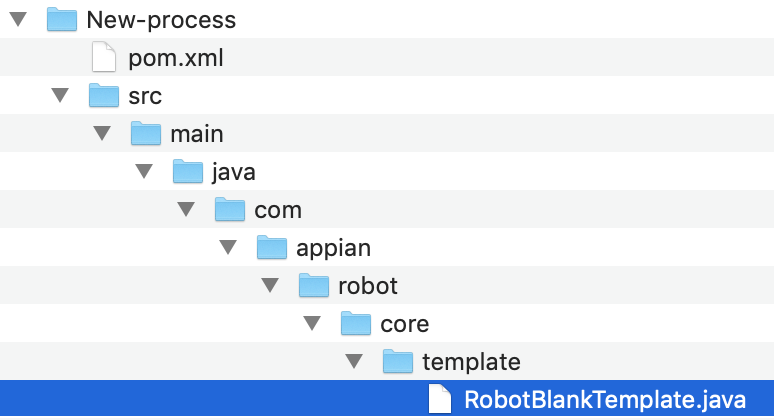| The capabilities described on this page are included in Appian's standard capability tier. Usage limits may apply. |
Tip: You can find the complete Javadoc documentation in the Appian RPA console. Click Help > Javadoc in the console menu.
Required role: Developer or Administrator
When you create an Appian RPA robotic task, the ZIP file of the source code automatically downloads to your computer. In addition, the Maven project automatically deploys in the repository.
Copy the downloaded file into the folder where you will develop the robotic task.
A robotic task's source code uses this structure:
pom.xml (contains robotic task information and configuration details Maven needs to build properly)Template.javaSome templates include more files. Visit the template documentation to learn more about what's included.
The source code looks like this in your computer's file system:

Appian RPA's Java modules are collections of interfaces, classes, and methods that developers can use in their code. These modules are designed for more experienced Java developers. These modules are organized based on common use cases, notably regarding the software a robotic task interacts with.
Note: Low-code modules are available for faster and more robust development.
The following modules are available in Appian RPA and are included in the jidoka packages listed in parentheses:
jidoka-client-api-appian): Contains methods for common actions interacting with Appian applications, such as calling web APIs, uploading documents, and downloading documents.jidoka-client-api): Available for every robot and provides the basic interfaces and classes needed to develop a robotic task. The interface IRobot is part of this module.jidoka-browser-api): Enables the robotic task to navigate and interact with web browsers.jidoka-falcon-api): Enables image processing and image recognition.jidoka-data-provider-api): Enables access to different data providers, such as Excel and ZIP files and folders.jidoka-msoutlook-api): Allows for easier handling in Outlook. This module uses Jacob to communicate with COM libraries provided by Outlook.jidoka-sap-api): Provides access to the available objects in SAP using SAP GUI Scripting.jidoka-client-api): Processes items in a queue from multiple robotic tasks running in parallel.jidoka-client-api): Utilize the UI-Automation framework to allow Windows applications to provide and consume information about a user interface (UI).For a list of all methods included in each module, consult the Javadocs in the Appian RPA Console. In the console, click Help > Javadoc in the left menu.
Appian RPA allows you to extend functionality by creating your own Maven projects and referencing default modules. The projects will end as .jar files in the repository, also known as Maven dependencies. The repository is where Appian RPA code and artifacts are stored. Developers deploy code to the repository when they develop or modify custom code. During an execution, this code is deployed to the robot.
To use a module in your robotic task, you must include its dependency in the pom.xml.
1
2
3
4
5
<dependency>
<groupId>com.novayre.jidoka.module</groupId>
<artifactId>package.name</artifactId>
<version>${jidoka.version}</version>
</dependency>
Modify the following values:
package.name is the name of the package that contains the specific module. For example, to add a dependency for the Browser module, it would be jidoka-browser-api. See the list above for the package name associated with each module.${jidoka.version} specifies the module's current version, which you can find in the following area:
1
2
3
<properties>
<jidoka.version>X.Y.Z</jidoka.version>
</properties>
Another way to extend module functionalities is by creating workflow libraries. Learn more about libraries.
For instances where you can't use low-code actions, you can also use robotic task variables in Java using the getWorkflowVariables() method of the IJidokaServer instance. This method returns a list of robotic task variables referenced in the workflow.
After retrieving the list of variables, you can then use the IRobotVariable interface to retrieve and modify the information about individual variables.
Note: You cannot update a variable's CDT value from the source code. To update a field in a CDT, you must use a low-code module.
For example:
1
2
3
4
5
6
7
8
//Gets the map of workflow variables containing those defined on the configuration page
Map<String, IRobotVariable> variables = server.getWorkflowVariables();
// Gets the variable called "var1"
IRobotVariable rv = variables.get("var1");
// Updates the value of var1 to the current value of item
rv.setValue(item);
To retrieve parameterized variables in your source code, use the getWorkflowParameters() method in the server instance. This method returns a list of parameterized variables defined in the console. The parameterized variables are also represented as IRobotVariable.